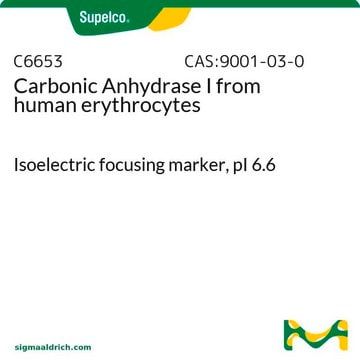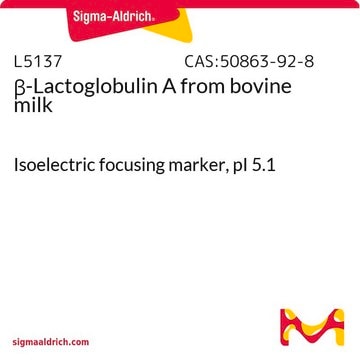Transportation information can be found in Section 14 of the product's (M)SDS.To access the shipping information for this material, use the link on the product detail page for the product.
Wichtige Dokumente
T1021
Trypsin inhibitor
powder, suitable for isoelectric focusing (IEF)
Synonym(e):
Hageman Faktor-Inhibitor, Popkorn-Inhibitor, SBTI
Größe auswählen
CHF 32.00
Größe auswählen
About This Item
CHF 32.00
Empfohlene Produkte
Produktbezeichnung
Trypsin-Inhibitor aus Glycine max (soybean), Isoelectric focusing marker, pI 4.6
Biologische Quelle
Glycine max (soybean)
Qualitätsniveau
Form
powder
Mol-Gew.
20,100 Da
Methode(n)
isoelectric focusing (IEF): suitable
pI
4.6
Löslichkeit
balanced salt solution: 1 mg/mL
concentrate: >10 mg/mL, hazy, amber-yellow
phosphate buffer: 10 mg/mL
water: 10 mg/mL
serum-free medium: soluble
Versandbedingung
ambient
Lagertemp.
−20°C
Suchen Sie nach ähnlichen Produkten? Aufrufen Leitfaden zum Produktvergleich
Biochem./physiol. Wirkung
Komponenten
Einheitendefinition
Angaben zur Herstellung
Lösungen können eine Aktivität behalten, wenn sie kurzzeitig bei 2–8 °C gelagert werden. Lösungen sind in gefrorenen Aliquoten bei -20 °C stabil.
Anwendung
Ähnliches Produkt
Hier finden Sie alle aktuellen Versionen:
Analysenzertifikate (COA)
Die passende Version wird nicht angezeigt?
Wenn Sie eine bestimmte Version benötigen, können Sie anhand der Lot- oder Chargennummer nach einem spezifischen Zertifikat suchen.
Besitzen Sie dieses Produkt bereits?
In der Dokumentenbibliothek finden Sie die Dokumentation zu den Produkten, die Sie kürzlich erworben haben.
Kunden haben sich ebenfalls angesehen
Protokolle
Natural trypsin inhibitors (serpins) regulate protein activation and catabolism by inhibiting serine proteases in vivo.
Chromatograms
application for HPLC-
What is the Department of Transportation shipping information for this product?
1 answer-
Helpful?
-
-
What is the molecular weight and amino acid sequence of trypsin inhibitor from Glycine max (soybean)?
1 answer-
Soybean trypsin inhibitor is a mixture of the three types. We have not characterized our trypsin inhibitor products in terms of how much of each of the three types may be present. All three have a molecular weight of between 20,000 and 20,200 daltons, so one might use 20,100 daltons as an average.The three types vary in the amino acids at a few positions. The detailed summary of the three types (or variants) was published in the following linked reference: J. Biochem. (Japan), 98, 435-448 (1985).Note that the authors use Tia, Tib and Tic to indicate the three variants.
Helpful?
-
Active Filters
Unser Team von Wissenschaftlern verfügt über Erfahrung in allen Forschungsbereichen einschließlich Life Science, Materialwissenschaften, chemischer Synthese, Chromatographie, Analytik und vielen mehr..
Setzen Sie sich mit dem technischen Dienst in Verbindung.











